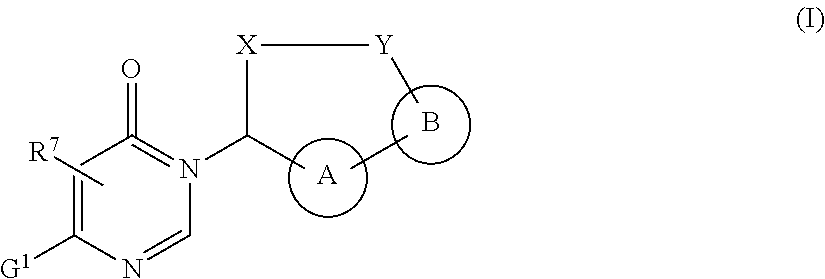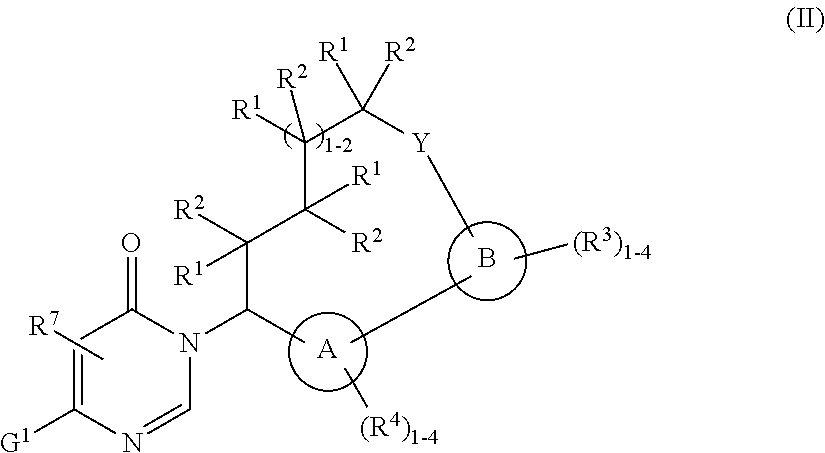Macrocycles with aromatic p2' groups as factor xia inhibitors
a macrocyclic compound and inhibitor technology, applied in the field of macrocyclic compounds, can solve the problems of abnormal abundance of plasma kallikrein-kinin system, limited use of no small molecule synthetic plasma kallikrein inhibitors have been approved for medical us
- Summary
- Abstract
- Description
- Claims
- Application Information
AI Technical Summary
Benefits of technology
Problems solved by technology
Method used
Image
Examples
example 1
Preparation of 2-(5,5-dimethyl-1,3,2-dioxaborinan-2-yl)-5-nitro-phenylamine
[0748]
[0749]To a flame-dried flask, equipped with a reflux condenser, containing 2-bromo-5-nitroaniline (10.0 g, 46.1 mmol), bis(neopentyl glycolato)diboron (13.01 g, 57.6 mmol), KOAc (13.57 g, 138 mmol), and PdCl2(dppf)-CH2Cl2 adduct (0.941 g, 1.152 mmol) was added DMSO (132 mL). The resulting dark red-brown suspension was degassed with Ar for 30 min and then the reaction was warmed to 80° C. After 4 h, the reaction was cooled to rt. The reaction was poured slowly into vigorously stirred ice-cold water (300 mL) to give a brown suspension. After stirring for 10 min, the suspension was filtered to collect the solid. The solid was rinsed with water (3×125 mL), air-dried, and then dried under a vacuum to give a brown solid. Purification by normal phase chromatography gave 4.36 g of 2-(5,5-dimethyl-1,3,2-dioxaborinan-2-yl)-5-nitro-phenylamine as an orange solid. MS(ESI) m / z: 183.1 (M-O5H8+H)+.
example 2
Preparation of (R)-2-methylbut-3-enoic acid
[0750]
2A. Preparation of (R)-4-benzyl-3-((R)-2-methylbut-3-enoyl)oxazolidin-2-one
[0751]To the solution of 2-methylbut-3-enoic acid (5.59 g, 55.9 mmol) and NMM (6.14 mL, 55.9 mmol) in THF (62 mL) at 0° C. was added pivaloyl chloride (6.87 mL, 55.9 mmol) dropwise. The reaction mixture was cooled to −78° C., and stirred for ˜2 h. In a separate flask: To the solution of (R)-4-benzyloxazolidin-2-one (8.25 g, 46.6 mmol) in THF (126 mL) at −78° C. was added 2.5 M nBuLi in hexane (20.49 mL, 51.2 mmol) dropwise. After 35 min, this reaction was transferred via cannula to the first reaction. The reaction mixture was stirred at −78° C. for 2 h, then the cold bath was removed, and the reaction was quenched with sat NH4Cl. The reaction was diluted with water and extracted with EtOAc (3×). The combined organic layers were washed with brine, dried over Na2SO4, filtered, and concentrated to give a yellow oil (15 g). Purification by silica gel chromatography...
example 3
Preparation of 6-(3-chloro-2-fluorophenyl)pyrimidin-4-ol
[0753]
[0754]A microwave vial containing 6-chloropyrimidin-4-ol (0.100 g, 0.766 mmol), (3-chloro-2-fluorophenyl)boronic acid (0.534 g, 3.06 mmol), and Pd(Ph3P)4 (0.089 g, 0.077 mmol) was purged with Ar for several min. Then degassed toluene (1.53 mL) and EtOH (1.53 mL) were added followed by DIEA (0.54 mL, 3.06 mmol). The vial was capped and the reaction was microwaved at 120° C. for 1 h. The resulting clear, orange solution was allowed to cool to rt and a precipitate formed. The yellow solid was removed by filtration, rinsing with 1:1 toluene / EtOH. A precipitate formed in the filtrate. The solid was collected by filtration, rinsed with cold 1:1 toluene / EtOH, air-dried, and dried under vacuum to give 6-(3-chloro-2-fluorophenyl)pyrimidin-4-ol (0.0357 g, 21% yield) as a white solid. MS(ESI) m / z: 225.1 (M+H)+ and 227.1 (M+2+H)+. 1H NMR (500 MHz, DMSO-d6) δ 12.71 (br. s., 1H), 8.31 (d, J=1.1 Hz, 1H), 7.87 (ddd, J=8.0, 7.2, 1.7 Hz, 1...
PUM
 Login to View More
Login to View More Abstract
Description
Claims
Application Information
 Login to View More
Login to View More - R&D
- Intellectual Property
- Life Sciences
- Materials
- Tech Scout
- Unparalleled Data Quality
- Higher Quality Content
- 60% Fewer Hallucinations
Browse by: Latest US Patents, China's latest patents, Technical Efficacy Thesaurus, Application Domain, Technology Topic, Popular Technical Reports.
© 2025 PatSnap. All rights reserved.Legal|Privacy policy|Modern Slavery Act Transparency Statement|Sitemap|About US| Contact US: help@patsnap.com



